Tree Rings, my most recent sculpture, was installed at Glen Villa a few weeks ago. Making this sculpture has been more challenging technically and mentally than I anticipated. Certainly it has taken longer than I thought it would.
The project began in September 2014 when the top of an old maple tree blew off during a heavy wind storm.
Luckily, the tree fell away from the house, causing no damage and leaving behind a 14 foot tree trunk with an interestingly uneven top.
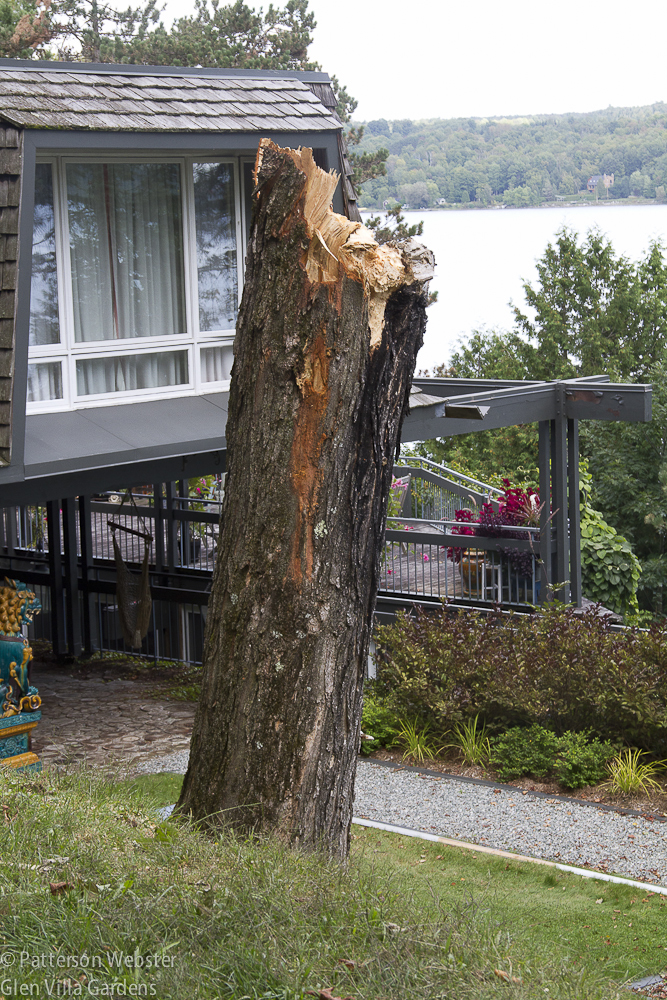
You can see how close the tree was to the house, and how lucky we were that it fell away from the house rather than towards it..
Without its top the tree was dead. The obvious thing was to remove what was left, either cutting the trunk off at ground level or removing it, roots and all. But something about the tree trunk urged me to leave it, at least for a while.
In a blog post written in September 2014, not long after the top blew off, I asked for ideas about what to do with the stub, technically called a snag. One person suggested cutting a wedge to determine the tree’s age. That idea made me consider the tree in a new way, to think less about its form and more about its life. Put simply, that suggestion inspired Tree Rings.
Rather than removing the snag, I decided to honour it. Over the winter months, I worked on a maquette, clarifying my ideas and determining dimensions. The plywood base of the maquette replicated the angle of the slope, a feature that had to be considered in any design.
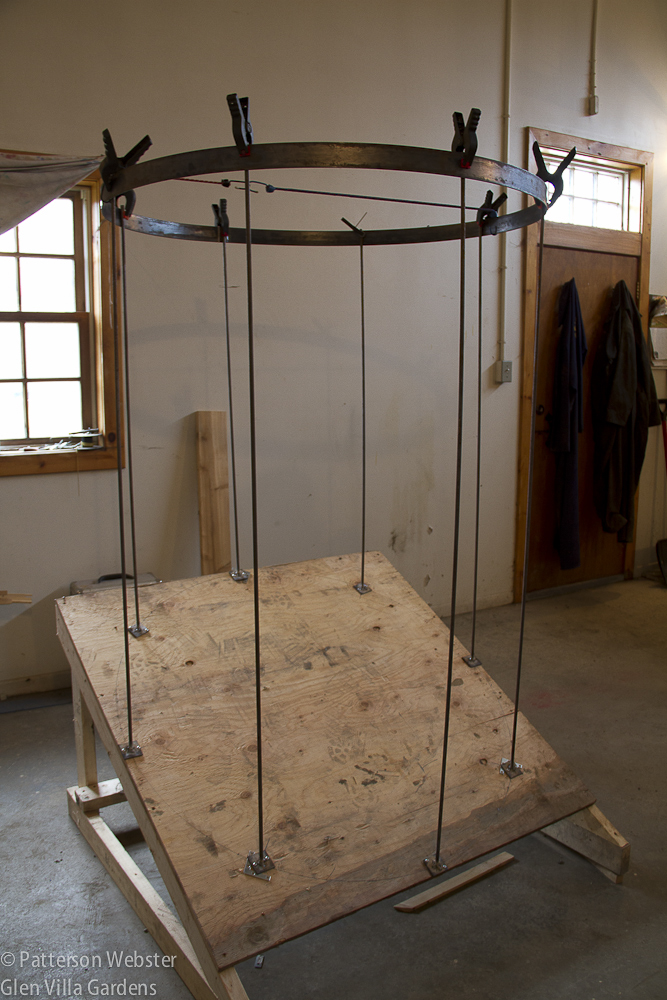
A maquette, or model, is essential when designing a large sculpture. I usually make a 1/12 model so that converting inches to feet is easy.
In July this year, in a blog post called What’s With the Weather? I announced that I was ready to begin work. I detailed what the finished sculpture would look like.
“Metal bands 9 feet in diameter will circle the tree, showing on the outside of the trunk the rings that normally are inside. Like these annual growth rings, the bands will vary in width. Some will be constructed of steel that rusts, others will be stainless steel. The stainless rings will be laser cut with dates and phrases that document important events in the life of the tree and what was happening around it, on the Glen Villa site.”
Sounds definitive, doesn’t it? Except that once I’d written that post, I began to second guess myself. Would the rings hide too much of the tree trunk? Did the dates and phrases I’d chosen honour the tree or simply list what had happened around it? And wasn’t a list a bit banal?
While I was uncertain about the words, I decided to begin nonetheless. I determined the final dimensions of the circle and the number of posts I needed to support the weight of the stainless steel rings. Jacques and Ken, my right-hand men and advisers on all things technical, determined that the holes for the posts couldn’t be dug by hand. So on a rainy day in July, the post hole digger arrived.
Digging the holes and inserting the metal sleeves for the posts was easy, although drilling through the roots of the tree meant the job took longer than expected.
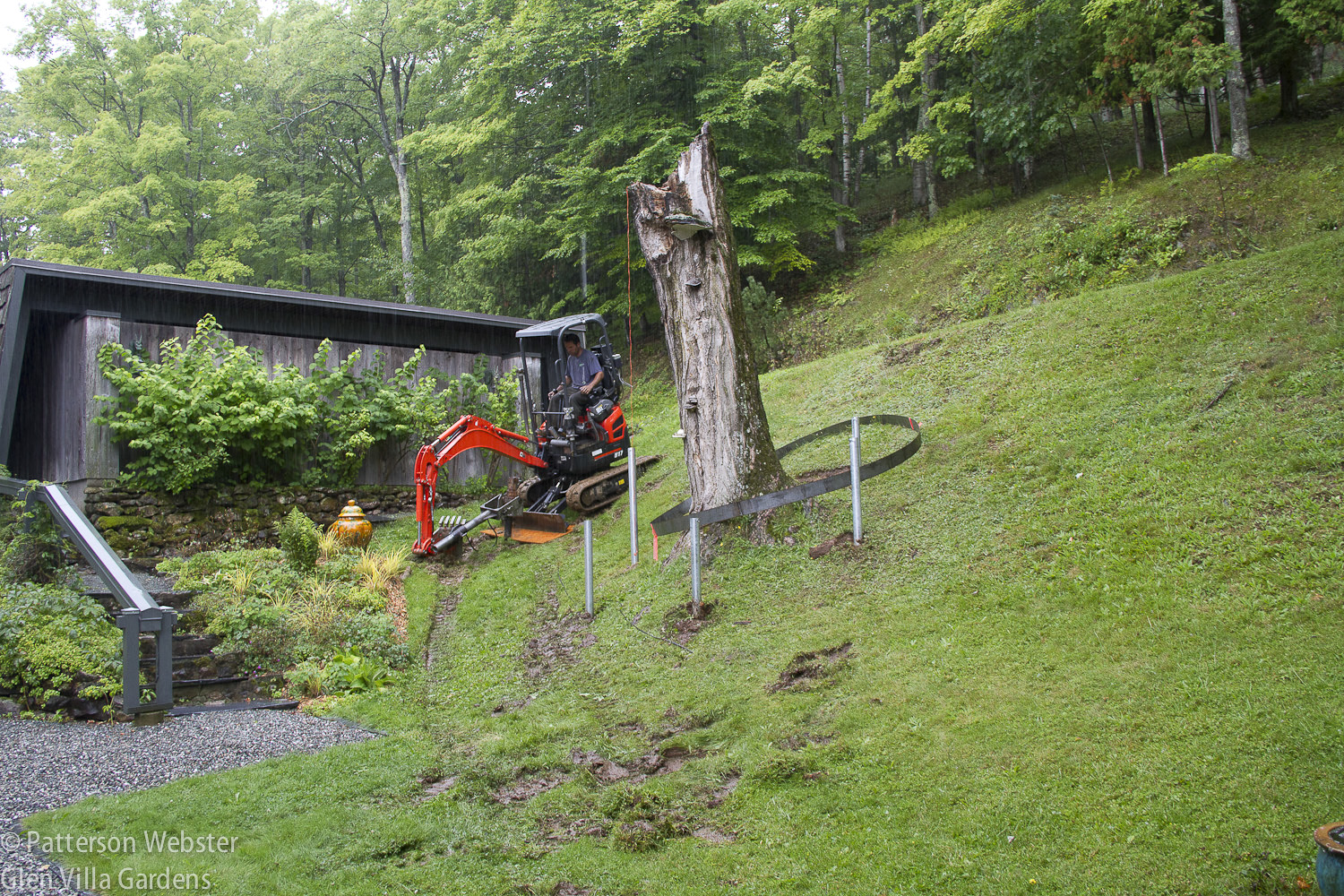
The metal bits sticking up go two feet underground to ensure that the steel posts inserted into them will remain upright and not shift when the ground freezes and thaws. The metal sleeves were cut off at ground level when the posts were installed.
Getting the machine back up the hill was not easy, since rain had softened the ground and made the muddy grass slippery.

I held my breath as the operator worked the machine back up the hillside, certain that at any moment the machine would begin to slip back down the hill. Eventually we had to bring in a tractor to winch the digger up the final bit.
The grass needed time to recover but everything else was ready to go. The machine shop was waiting for the final design and would begin fabricating the rings and laser cutting words into the steel as soon as I gave the ok. But still I hesitated. I knew that something was wrong. The words I’d chosen didn’t capture the spirit I was searching for.
So I started again. I considered other approaches, expressed in other ways. I knew I wanted to incorporate dates, not to show the history of the site but to acknowledge the life span of the tree. Dates alone weren’t enough, though. I needed a phrase or two that encapsulated that life, that spoke to the many things that had happened to the tree as it aged. I didn’t want a lot of words; in fact, I wanted as few as possible.
Finding those words took many hours, spread over a month or more. I tried different versions on my increasingly impatient family, until finally I hit on the words that, for me, said it all.
A date would appear on the lowest ring, circa 1848, my estimate of the tree’s age based on its girth five feet above the ground. The top ring would have another date, 2014, the year the tree died.
In the same way that I had reduced the number of words, I reduced the number of rings, from my original plan of one ring for every year of the tree’s life to only a few. The rings would differ in width to reflect how the tree had grown, more in some years, less in others. With the post holes in place, mocking up a full size model to determine the exact number and placement of rings took almost no time at all. Jacques and Ken cut strips of tin and I tried various arrangements before finally making a decision.

The bottom rings don’t form full circles but die into the slope of the hill. Or thinking about this in reverse, they grow out of the ground to form a ring, echoing the way the tree itself grew.
The final step was deciding how large the words should be and what they should look like. Tim Doherty, a graphic designer in Lennoxville, Quebec, was instrumental in this final part of the planning.

How large should the lettering be? Tim printed samples in different sizes and that made the decision clear.
Richard Duquette, of Conception Duquette in Waterville, Quebec, fabricated the rings following my final design. Each stainless steel strip was bent into a circle and welded on site.

The stainless steel rings are attached to the steel posts by 3 inch bolts. The posts mimic the architecture of the house. Over time these posts will rust, the rings will not.
The rings went up one by one, and since each one had to be levelled, bolted and welded, the work took two full days. Rain didn’t speed things up.

The date 2014 appears on the highest ring which was the first to installed. Here, the ring with the crucial words is being welded…
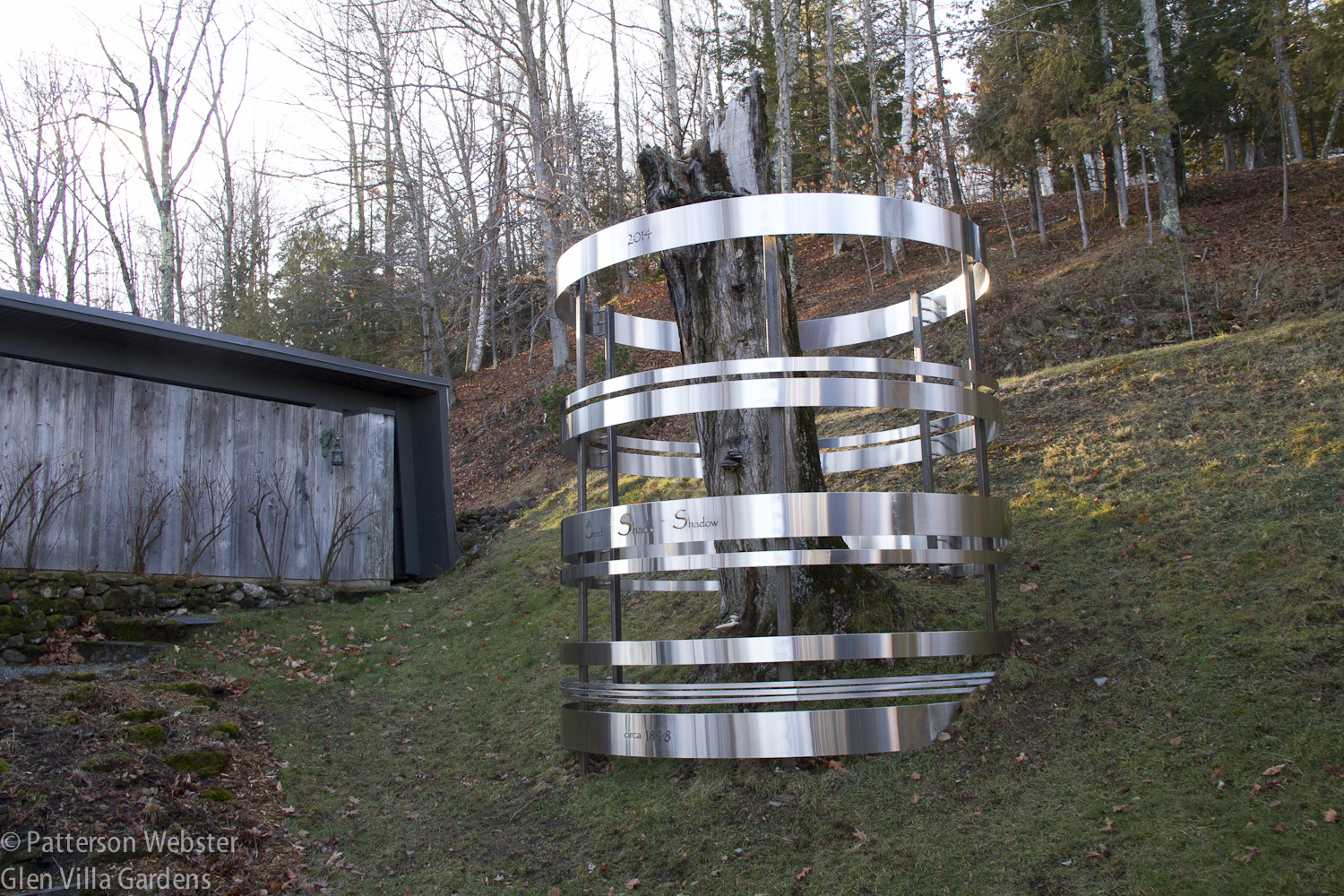
I have not yet managed to photograph the finished sculpture to my satisfaction. That will come with time, I hope.
I’m eager to see the sculpture in the winter, when the ground is covered with snow. So far, we’ve had a light dusting only, but even that little bit shows how strong the shadow of the tree and its rings will be.

Tree Rings with a dusting of snow.
I’m eager to see Tree Rings in the spring, when leaves begin to emerge on the trees that surround my shadow of a tree. I’m eager to see it in summer, when those leaves are fully green, and in autumn, when their colours will be reflected in the stainless rings.

The rings reflect light and colour in unexpected ways. I like that.


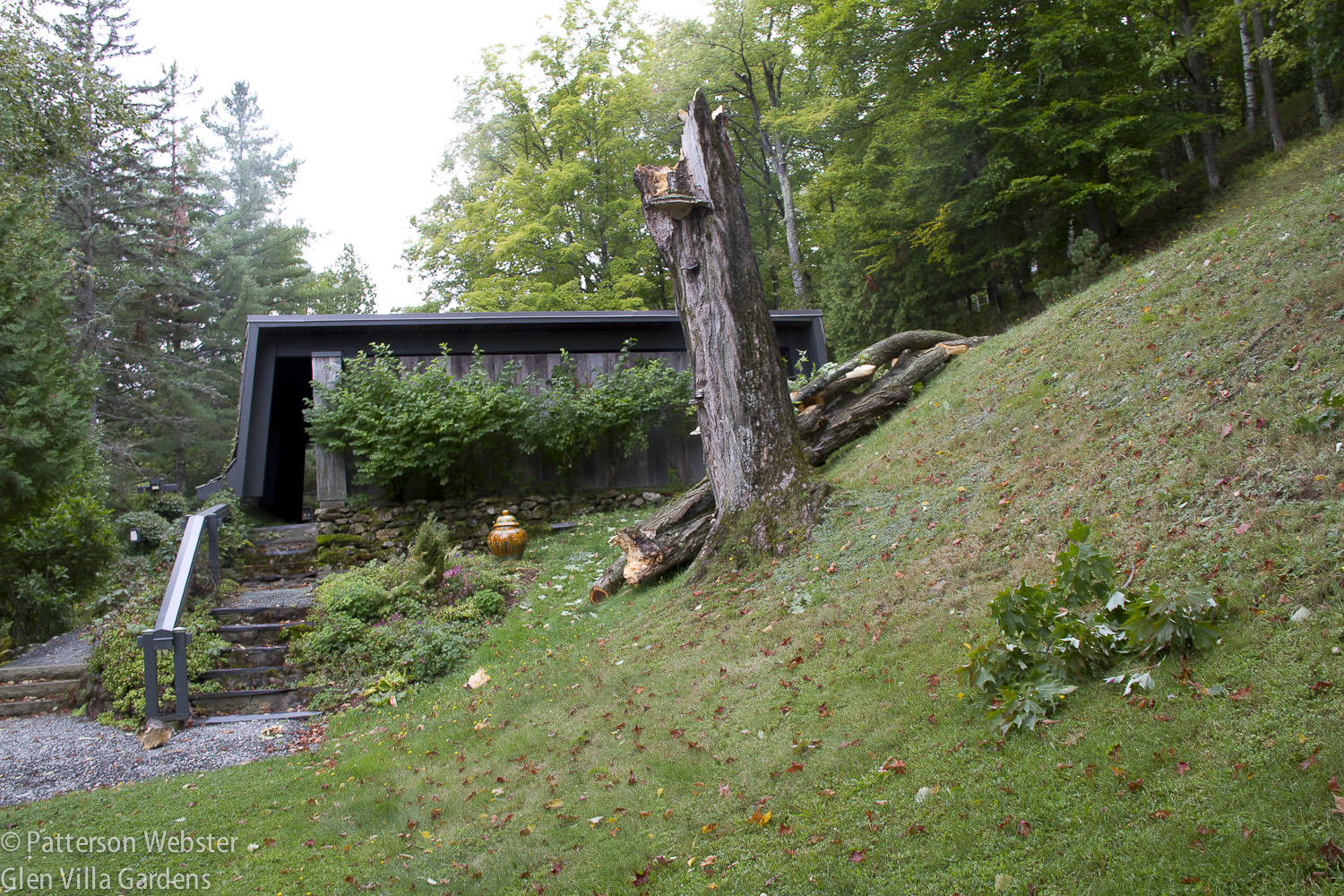
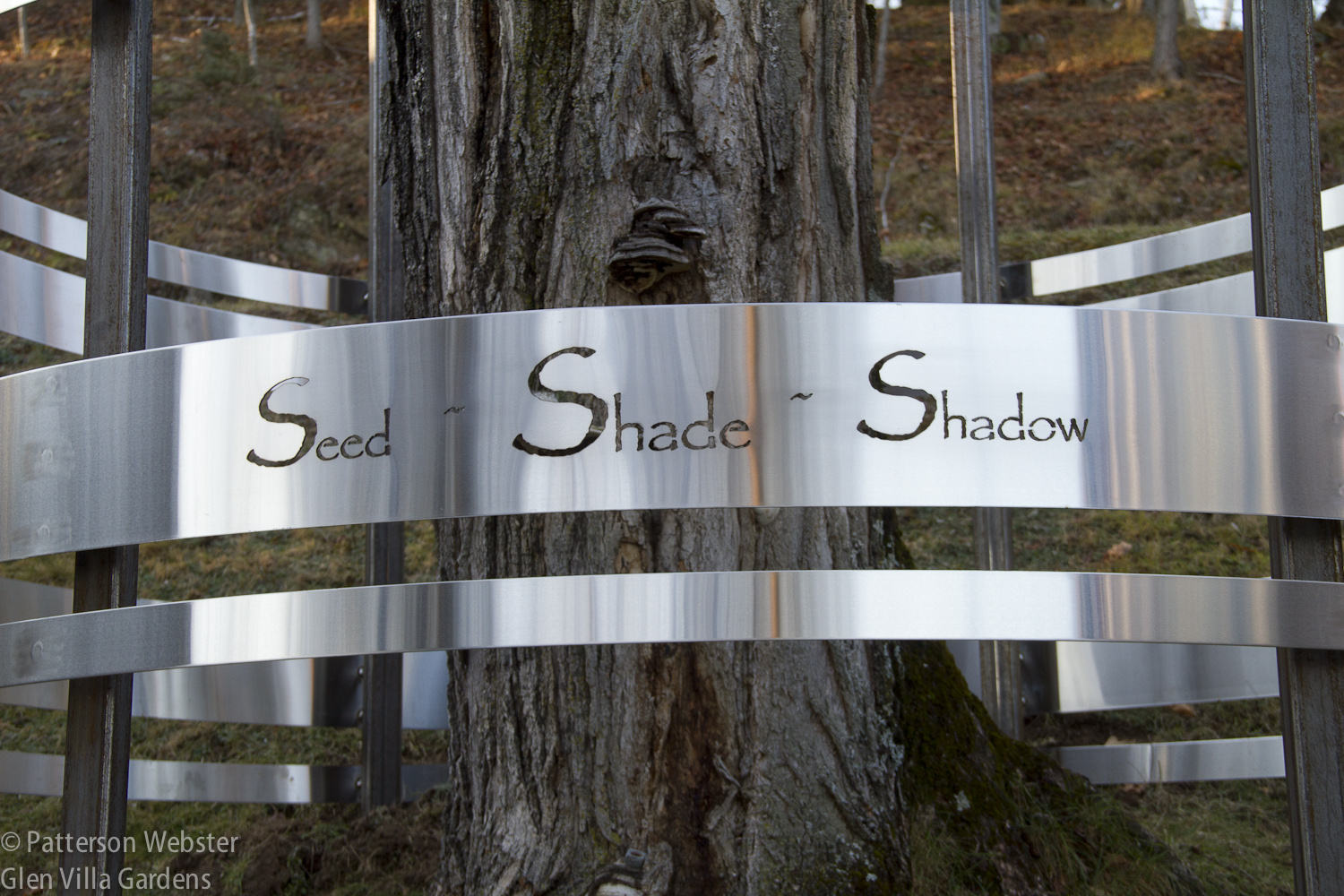




A wonderful conception honouring the longevity of 166 years, the unusual stump, and the play of light, colour and shadows.
Thank you, Alison. I appreciate the feedback.
Looking forward to many colors that this will display with the change of seasons/light….keep the pictures coming please! Reflections of a tree long ago!
I like your comment, Robert… reflections on reflections. I give a talk on this topic and it hadn’t occurred to me to add Tree Rings. Now I will.
I love this concept, Pat, and think the key, as you suggest, is how it “lives” in the garden as time marches on. The rings convey an energy to the dead stump that honors its former life. Pam/Digging: http://www.penick.net/digging
Thanks, Pam. Today, with mist all around, Tree Rings looks quite different than it did the day before when the sun was shining. It will change with time, and that’s a positive quality in my mind.
I’m amazed by this large and impressive piece. I hope it continues to grow in beauty and sentiment, as the tree itself did.
Thank you, Marian. I hope it will grow in beauty as well. I find that I am liking it more each day, so that’s a start.
Thanks so much for sharing your process with us. The sculpture is beautiful and does indeed honor the tree.
Sharing the process was interesting, Jean. I had forgotten how my thoughts had changed and developed so reviewing was helpful in evaluating the finished sculpture. I’m glad you think it honours the tree.
That’s beautiful, Pat! Your vision and talent yielded a stunning project. That must have been a challenging site with such a steep incline. The final sculpture is wonderful.
The slope was a killer — it made measuring anything and everything very difficult. Thank you for the compliment — I really appreciate it.
Beautiful. A wonderful monument to your old arboreal friend. And much more impressive than the mock up that I too for the final product when we were there in August!
Yes, the tin version wasn’t very sturdy or impressive. I’m glad you like it, Jason.